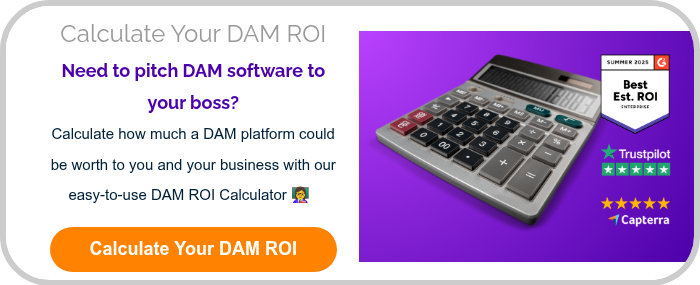
Digital Asset Management ROI: The Business Case for a DAM
Digital asset management software; you’ve heard about it, you've researched it, and now you’re convinced - it’s the solution you always knew you needed but never knew existed.
But you know your boss/board/budget holders will need to see a clear business case before they sign off the budget. They’ll want to know the return on investment (ROI) a Digital Asset Management (DAM) system can bring their organisation.
Firstly, there’s no one-size-fits-all answer. However, using DAM software brings clear financial benefits. This is especially true for organisations that handle many digital assets, launch a number of campaigns across the year, and have multiple teams using assets across different locations.
Calculating DAM ROI isn’t just about crunching numbers (although we can do that below), it’s about seeing the bigger picture.
How much time is your team wasting searching for files? How often do people end up re-creating assets because originals are lost in a maze of folders?
How much frustrated energy is spent on dead-end searches or trawling through email chains to ascertain, “WHICH WAS THE FINAL VERSION??”?
And how much does all that cost?
When you look at how much money is spent on manually managing assets, or manhandling them through legacy tech, it can be surprising. By comparing this method to the efficiency and cost savings of a DAM system, you can see how much DAM software could save you.
Let’s dive into the major factors that drive DAM ROI and how your organisation can make some major savings. In this article, expect to learn:
- What is Digital Asset Management ROI?
- What Contributes to DAM ROI?
- How to calculate Digital Asset Management ROI – and How To Build a Business Case for a DAM
- Is a DAM System Worth the Investment?
Let's dig in!
What is Digital Asset Management ROI?
Digital Asset Management ROI refers to the financial return an organisation achieves by implementing a DAM system. ROI is measured by how much time and money is saved because of improved organisation, searchability and more efficient asset distribution.
For example, if your marketing team spends hours looking for the right files, it costs your business money. If they hire designers to recreate assets because the originals are hard to find, that also wastes money. A DAM system eliminates these challenges, leading to faster workflows and reduced operational costs.
What Contributes to DAM ROI?
Several factors determine the return on investment when adopting a Digital Asset Management system.
1. DAM Software Can Save 20% of Employee Time
A DAM system dramatically reduces the time spent searching for and distributing assets. According to industry reports, employees spend an average of 19% of their workweek (let’s say 20%, which is one day a week!) looking for information. Hours of wasted time.
How to Calculate Time Lost to Poor Digital Asset Management: Looking at an example of this for an employee on a £35,000 salary and a standard working week:
- 20% of a 37.5 hour working week is 1 day or 7.5 hours. (Just think, over a year that’s 52 days or 390 hours!)
- On an average salary annual of £35,000, this would mean time spent looking for assets equates to £7,000 (20% of £35K).
- If you have a team of 4, and £35,000 is the average salary, then the average annual cost to the business would be £28,000 (£7,000 x 4 employees).
2. DAMs Reduce Digital Asset Duplication
Without an easy-to-use, centralised system, teams can accidentally create or purchase assets they already have. This causes unnecessary duplication. It also means your team spends more time and money commissioning replacement content. In turn, this leads to higher storage costs and wasted resources, not to mention the extra man hours!
See it in practice: Let's say, each year, your company spends £10,000 on stock images. However, 30% of these images are duplicates. A DAM system prevents this waste, leading to a potential saving of £3,000 per year.
Or consider this scenario: Imagine that the team created specific graphics for a campaign that launched last year. You know there are assets you can reuse, but you can’t find them. So you brief in a replacement set, wasting precious time and money.
3. DAM Systems Maintain Brand Consistency & Compliance
Making sure all marketing and sales teams use approved, up-to-date assets is critical for brand consistency. Outdated marketing collateral can undermine brand reputation and integrity. A DAM system provides version control and access restrictions, ensuring teams only use the correct materials.
For example: You use an image on social media which you didn't have the rights to use and now have been met with a copyright infringement claim.
Protecting your brand with a DAM platform keeps your brand consistent, professional, and most importantly compliant.
4. DAMs Increase Marketing Campaign Efficiency
Marketing teams rely on instant access to digital assets for campaigns, social media, and advertisements. Ditto PR teams who need to get in front of the press before the competition. A DAM speeds up this process, helping teams launch campaigns faster and respond to market trends in real-time.
In practice: A company takes three weeks to launch a campaign due to slow asset retrieval. They miss exclusivity on PR coverage because a rival brand got to press teams ahead of them. After implementing a DAM, they significantly reduce this timeframe, improving their speed-to-market and competitive edge.
5. DAM Software Streamlines Collaboration & Workflow Automation
DAM software helps teams work better together. It allows various teams, both within the company and outside, to access and approve assets in one central system. Automated workflows improve efficiency and eliminate bottlenecks.
Example: A global organisation with multiple departments using different tools experiences delays in approving assets. Cue a DAM system! The tech integrates with existing marketing automation and project management tools, creating a seamless workflow and improving productivity. Hurrah!
How to calculate Digital Asset Management ROI
To quantify your DAM ROI, compare the before-and-after costs of managing digital assets. Here’s a simple DAM ROI formula to estimate potential savings:
DAM ROI Formula:
(Time Saved + Cost Savings) ÷ Investment Cost × 100 = ROI (%).
Using our example numbers from earlier, let's do some quick maths...
Time saved (390 hours per person, per year x 4 people): 1,560 hours
Wages Saved (4 employees on £35k): £28,000
Cost savings: £3,000 from reduced asset duplication and storage costs
Investment in DAM system: £10,000 per year
CALCULATION: (£3,000 + £28,000) ÷ £10,000 × 100 = 310% ROI
A return of 310% indicates that for every £1 spent on the digital asset management system, the business gains £3.10 in value.
Extra Metrics to Build Your Business Case for a DAM:
- Number of assets managed – Consider how many digital files your organisation stores and uses.
- Search time per asset – What's the average time spent finding a specific asset before and after DAM implementation.
- Asset duplication rate – Do you know the percentage of assets recreated because they're too hard to find?
- Campaign launch speed – Think about the time it takes to launch marketing campaigns before and after DAM adoption.
Tips for Building a Business Case for a DAM Solution
Gain buy-in from stakeholders - it's crucial to successfully implementing a DAM system. Here’s how to make a compelling case for the benefits of DAMs:
1. Identify People's Pain Points
People like to be heard. So, collect data on their current digital asset filing problems. Look for issues like time lost searching for files, inconsistent branding, or duplicate assets. Show how a DAM system can fix these problems.
2. Highlight Cost Savings
Demonstrate how a DAM system reduces unnecessary spending on asset recreation, storage, and lost productivity. Use real-world examples and calculations to make the case stronger.
3. Demonstrate Uptick in Efficiency
Explain how a DAM system helps improve workflows, speeds up project completion and enhances teamwork, making processes smoother and more effective and means teams can find and share assets easily, meaning they can work together better and finish projects faster.
Overall, DAM software makes work easier for everyone involved. Use product tours to help showcase your point.
4. See How Your Competitors Save Time with DAMs
Showcase how other companies in your industry are benefiting from DAM software. Providing case studies or industry benchmarks can strengthen your argument.
5. Take Part in a DAM demo!
Stakeholders may be more receptive if they can see the system in action. Arrange for a demo or a free trial of the DAM system to allow them to experience the benefits firsthand.
👉👉 Check out our guide on Solving MarTech Adoption 👈👈
By implementing the right DAM software and ensuring proper user adoption, you can significantly improve efficiency and maximise your ROI.
Is a DAM System Worth the Investment?
For businesses dealing with a large volume of digital assets, a Digital Asset Management system is not just a tool, it’s a necessity.
Our clients are testament to this, spanning universities, charities and Not-For-Profits, travel brands, manufacturing, construction and retail, who all value the benefits of a solid digital asset management platform.
The ROI of a DAM is clear: time savings, cost reduction, improved brand consistency, and faster marketing execution all contribute to long-term financial benefits. And much, MUCH, happier teams.
Want further reading? Download the Business Advantages of DAM Software eBook here.
.png?width=232&height=232&name=Chat%20to%20Us%20600%20x%20600px%20(7).png)
Let’s chat!
Ready to see how a DAM system can boost your ROI? Let’s chat! Our team’s here to help with a personalised, no obligation consultation - just reach out!




